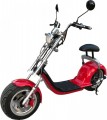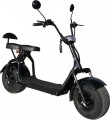Range
The range of a vehicle is the distance it can travel on a single battery charge.
Note that the range usually indicates the value for perfect operating conditions: driving at optimal speed with a small load, flat road, no ups and downs, etc. The actual range may differ from the claimed one, sometimes quite noticeably. In addition, to improve range, manufacturers can deliberately use low-power motors that consume little energy.
Max speed
The highest speed that a vehicle can reach.
When choosing according to this parameter, it is worth considering that in dense city traffic, it is rarely possible to accelerate faster than 40 km/h; so if the vehicle is bought mainly for a comfortable ride through traffic jams, then there is no need to look for a high-speed model. In addition, for the same motor power, low speed means more torque, which makes it easier to climb hills.
Clearance
Vehicle clearance.
Clearance is the distance from the ground to the lowest point of the vehicle (excluding wheels). Roughly speaking, this is the highest height of an object that can fit under the vehicle without being hit the body.
The higher the clearance — the higher the obstacles that the unit can cope with, the lower the likelihood that when overcoming another pothole or bump, the body will touch the ground. On the other hand, low ground clearance lowers the centre of gravity and improves overall stability; so for roads with high-quality pavement and other flat surfaces, it is the smaller clearance that is considered optimal.
Power
The motor power of a vehicle, in horsepower.
In general, the power of electric motors is indicated in watts. However, in electric transport, this designation is also often indicated. This is done for the convenience of comparison with internal combustion engines: for internal combustion engines, especially in vehicles, horsepower is traditionally used, and it is more convenient for some users to evaluate the power of motors by this designation. At the same time, if the need arises, some units are easily converted to others: 1 hp. ≈ 735 W.
For the power value in general, see the relevant paragraph below.
Power
The motor power of a vehicle, in kilowatts. In addition to them, horsepower is also used (for more details, see above).
Let us clarify that in this case, we are talking about
maximum power; the actual power can be adjusted while driving with the help of the accelerator. And in some models, it may even be possible to set a limit on the maximum power.
A more powerful motor allows you to carry more weight, reach higher speeds and/or have more torque. However, the energy consumption from the battery will also be high, and the battery life, with the same battery capacity, will be correspondingly less than when using a less powerful motor. Also note that in many countries, motor power is a criterion for classifying an electric vehicle as one or another variety. For example, according to this criterion, motorcycles and scooters can be formally separated, requiring different driving licences.
Weight
The total weight of the vehicle without cargo and rider.
The
lighter the unit, the greater the range and, accordingly, the weight of the payload that can be carried on it. On the other hand, too little weight adversely affects the stability, and sometimes the overall strength of the structure.

